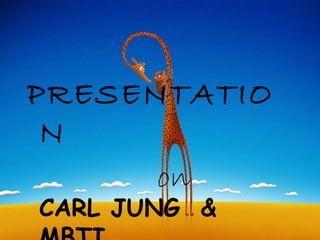Signaler
Partager

Recommandé
Recommandé
Contenu connexe
Tendances (20)
Analytical psychology Theories of Personality Carl Jung

Analytical psychology Theories of Personality Carl Jung
Similaire à Presentation
Similaire à Presentation (20)
Section I Your Dimension ResultsThis section will explain how y.docx

Section I Your Dimension ResultsThis section will explain how y.docx
Narrative presentation - how we construct our meaning and consciousness

Narrative presentation - how we construct our meaning and consciousness
What Lies Beneath: Personality theories simplified

What Lies Beneath: Personality theories simplified
Youre not crazy its just your personality type workshop slideshow by michelle...

Youre not crazy its just your personality type workshop slideshow by michelle...
Dernier
This presentation was provided by William Mattingly of the Smithsonian Institution, during the fourth segment of the NISO training series "AI & Prompt Design." Session Four: Structured Data and Assistants, was held on April 25, 2024.Mattingly "AI & Prompt Design: Structured Data, Assistants, & RAG"

Mattingly "AI & Prompt Design: Structured Data, Assistants, & RAG"National Information Standards Organization (NISO)
Dernier (20)
A Critique of the Proposed National Education Policy Reform

A Critique of the Proposed National Education Policy Reform
Kisan Call Centre - To harness potential of ICT in Agriculture by answer farm...

Kisan Call Centre - To harness potential of ICT in Agriculture by answer farm...
Interactive Powerpoint_How to Master effective communication

Interactive Powerpoint_How to Master effective communication
BAG TECHNIQUE Bag technique-a tool making use of public health bag through wh...

BAG TECHNIQUE Bag technique-a tool making use of public health bag through wh...
Mattingly "AI & Prompt Design: Structured Data, Assistants, & RAG"

Mattingly "AI & Prompt Design: Structured Data, Assistants, & RAG"
Presentation by Andreas Schleicher Tackling the School Absenteeism Crisis 30 ...

Presentation by Andreas Schleicher Tackling the School Absenteeism Crisis 30 ...
IGNOU MSCCFT and PGDCFT Exam Question Pattern: MCFT003 Counselling and Family...

IGNOU MSCCFT and PGDCFT Exam Question Pattern: MCFT003 Counselling and Family...
Measures of Central Tendency: Mean, Median and Mode

Measures of Central Tendency: Mean, Median and Mode
Presentation
- 1. PRESENTATIO N on CARL JUNG &
- 2. CONTENTS History Carl Jung and his theory MBTI Balance of personalities
- 3. HISTORY •Carl Jung was a Swiss psychiatrist . •His theory was built on a notion that people are fundamentally different but also alike. •Acc to him the whole population is divided in two basic types- extrovert and introvert •His theory is a part of psychodynamic theory.
- 4. 3 Levels of Consciousness: Ego: conscious level; carries out daily activities; Personal Unconscious: individual’s thoughts, memories, wishes, impulses; like Collective Unconscious: storehouse of memories inherited from the common ancestors of the whole human race;
- 5. Extraversion/Introversion Characteristics An Extravert… An Introvert… Expresses Thoughts Keeps Thoughts and and Emotions Freely Emotions Private Needs Relationships (May be at Risk of Saying too little) Gives Breadth to Life Needs Privacy E’s may Seem Gives Depth to Life Shallow to I’s I’s may Seem Is Often Friendly, Withdrawn to E’s Talkative, Easy to Is Often Reserved, Know Quiet, Hard to Know
- 6. Extravert Introvert Extraversion Introversion Active Reflective Outward Inward Sociable Reserved People Privacy Expressive Quiet
- 7. Why Do We Care about our Type? The daughter-mother ,Isabel and Catherine briggs , developed CJ theory into usable methodology & system for understanding and interpreting personality in 1942. Set up Dichotomies to reflect Carl Jung’s theory of Psychological Types Dichotomies E/I; S/N; T/F; J/P The MBTI is a powerful personality profile that gives you insight into your own and other preferences for how you learn, how you make decisions, for how you communicate, and for managing time and energy. This effects every aspect of your life.
- 8. Thinking: naming and interpreting experience. Feeling: evaluating an experience for its emotional worth to us. Sensing: experiencing the world through the senses without interpreting or evaluating it. Intuiting: relating directly to the world without physical sensation, reasoning, or interpretation.
- 9. Sensing/Intuition A Sensor… An Intuitor… Sees Specific Parts Sees Patterns and And Pieces Relationships Lives in the Present Lives Toward the Enjoying What’s There. Future, Anticipating Prefers Handling What Might Be Practical Matters Prefers Imaging Likes Things That Are Possibilities Definite, Measureable Likes Opportunities for S’s may seem Being Inventive Materialistic and N’s May Seem Fickle, Literal Minded to Ns Impractical Dreamers to S’s
- 10. Thinking/Feeling Thinking Feeling Thinking Feeling Head Heart Objective Subjective Justice Harmony Cool Caring Impersonal Personal Critique Analyze Appreciates Precise Empathize Principles Persuasive Values
- 11. Judging/Perception Judging Perceiving Judgment Perception Organized Flexible Structure Flow Control Experience Decisive Curious Deliberate Spontaneous Closure Openness Plan Wait Deadlines Discoveries Productive Receptive
- 12. Balance Judgment Needs Perception for Balance. Judging Types use Both J and P But they Prefer J Perception Needs Judgment for Balance. Perceiving Types use Both J and P But they Prefer P Thinking Needs Feeling for Balance. Thinking Types use Both T and F But they Prefer T. Feeling Needs Thinking for Balance. Feeling Types use Both T and F But they Prefer F. Sensing Types use Both S and N But they Prefer S. Sensing Needs Intuition for Balance Intuition Needs Sensing for Balance. Intuitive Types use Both S and N But they Prefer N
- 13. PRESENTATION BY ASHISH SHARMA PARUL SHANKER